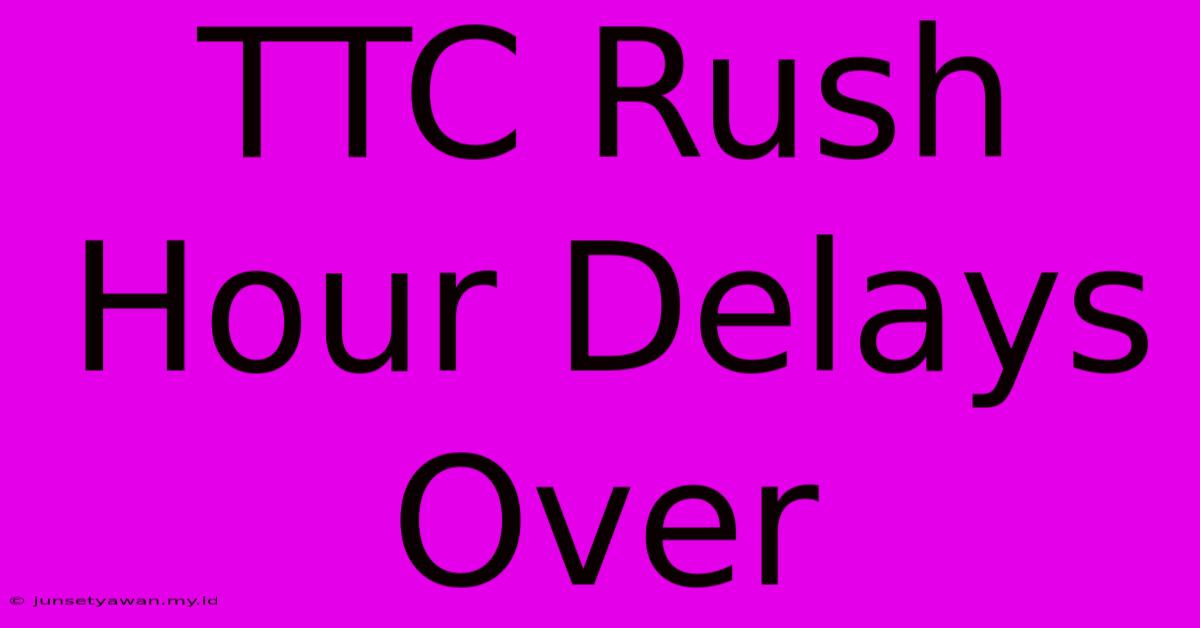TTC Rush Hour Delays Over

Temukan informasi yang lebih rinci dan menarik di situs web kami. Klik tautan di bawah ini untuk memulai informasi lanjutan: Visit Best Website meltwatermedia.ca. Jangan lewatkan!
Table of Contents
TTC Rush Hour Delays Finally Over: Good News for Commuters!
Meta Description: TTC rush hour delays are finally over! Learn about the causes of the delays, the solutions implemented, and what commuters can expect now. Read more for smoother commutes!
The Toronto Transit Commission (TTC) has announced that the significant rush hour delays plaguing commuters are finally over. This welcome news follows weeks of frustration and overcrowded vehicles caused by various issues impacting TTC service reliability. Let's delve into what caused these delays and what steps have been taken to improve the situation.
Understanding the Sources of TTC Rush Hour Delays
For several weeks, commuters faced frustrating delays during peak hours. Several factors contributed to this widespread disruption of TTC operations:
Track Maintenance and Repairs
Significant track maintenance and repair projects were underway across various lines, resulting in service interruptions and delays. These projects, while necessary for the long-term health of the TTC infrastructure, significantly impacted TTC rush hour service. The sheer scale of the work, combined with unforeseen complications, led to prolonged disruptions.
Signal System Issues
The TTC's aging signal system experienced several malfunctions, causing delays and temporary shutdowns on certain lines. These signal problems, particularly during peak hours, exacerbated the already strained network, leading to further TTC delays. This highlighted the urgent need for modernization of the TTC's infrastructure.
Increased Passenger Volume
The return to in-person work after the pandemic, coupled with an increase in tourism, resulted in higher passenger volume on TTC vehicles. This surge in ridership, exceeding the capacity of some lines, contributed to overcrowding and increased TTC travel times.
Solutions Implemented by the TTC
In response to the public outcry and significant disruption, the TTC implemented several crucial solutions:
- Accelerated Track Repairs: The TTC prioritized and accelerated the completion of the major track maintenance projects. They implemented overtime schedules and optimized their work processes to minimize further disruptions.
- Signal System Upgrades: A significant investment in upgrading the aging signal system was expedited. While complete modernization is a long-term project, immediate fixes were implemented to improve system reliability.
- Increased Service Frequency: During peak hours, the TTC increased the frequency of service on several lines to accommodate the higher passenger volume. Additional vehicles were deployed where possible to reduce overcrowding.
- Improved Communication: The TTC improved its communication channels, providing real-time updates and more accurate information to commuters through their website and mobile app. This transparent approach helped manage expectations and reduced frustration among passengers.
What to Expect Now
With the major track repairs complete and the signal system stabilized, commuters can expect a significant improvement in TTC rush hour service. While minor delays may still occur, the frequency and severity of the disruptions should be dramatically reduced. The TTC continues to monitor the situation and will make further adjustments as needed. The long-term solution requires continued investment in infrastructure upgrades and modernization. This investment will ensure a more reliable and efficient transit system for all Torontonians. Remember to check the TTC website or app for any potential service alerts before starting your commute.
For more information on TTC updates and planned maintenance, visit the official . For a detailed overview of public transportation in Toronto, see our article on "." Understanding the TTC's challenges and ongoing improvements helps us all appreciate the important role it plays in our city.

Football Match Schedule
Upcoming Matches
Latest Posts
Terimakasih telah mengunjungi situs web kami TTC Rush Hour Delays Over. Kami berharap informasi yang kami sampaikan dapat membantu Anda. Jangan sungkan untuk menghubungi kami jika ada pertanyaan atau butuh bantuan tambahan. Sampai bertemu di lain waktu, dan jangan lupa untuk menyimpan halaman ini!
Kami berterima kasih atas kunjungan Anda untuk melihat lebih jauh. TTC Rush Hour Delays Over. Informasikan kepada kami jika Anda memerlukan bantuan tambahan. Tandai situs ini dan pastikan untuk kembali lagi segera!
Featured Posts
-
Man Utd Arsenal Complete Match Report
Dec 05, 2024
-
50 Milyon Euro Real Madrid In Yeni Sag Beki
Dec 05, 2024
-
Premier League Live Slots Dig
Dec 05, 2024
-
Brian Thompson Slain United Healthcare Ceo
Dec 05, 2024
-
Racing Estudiantes Canal De Transmision
Dec 05, 2024
